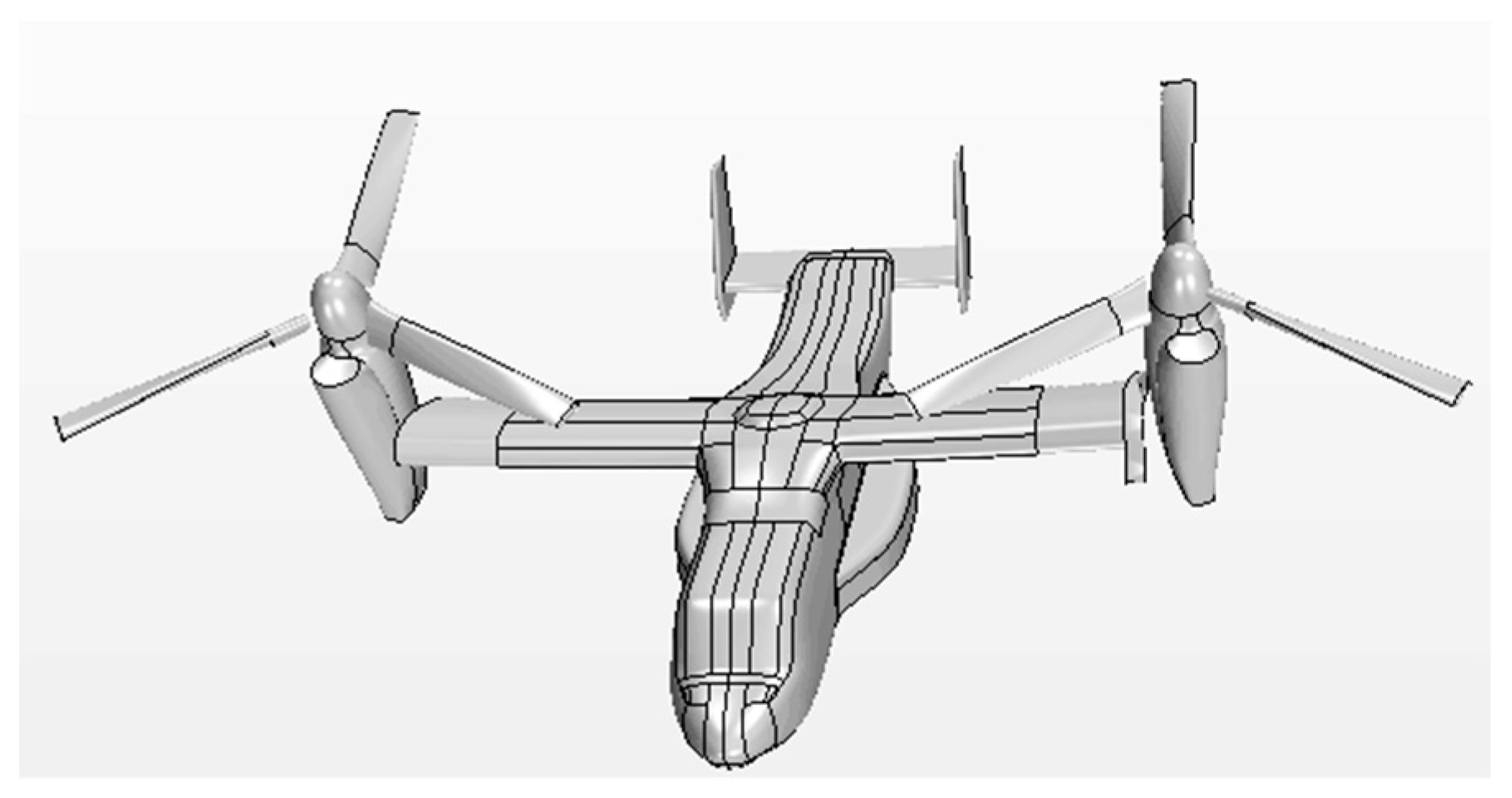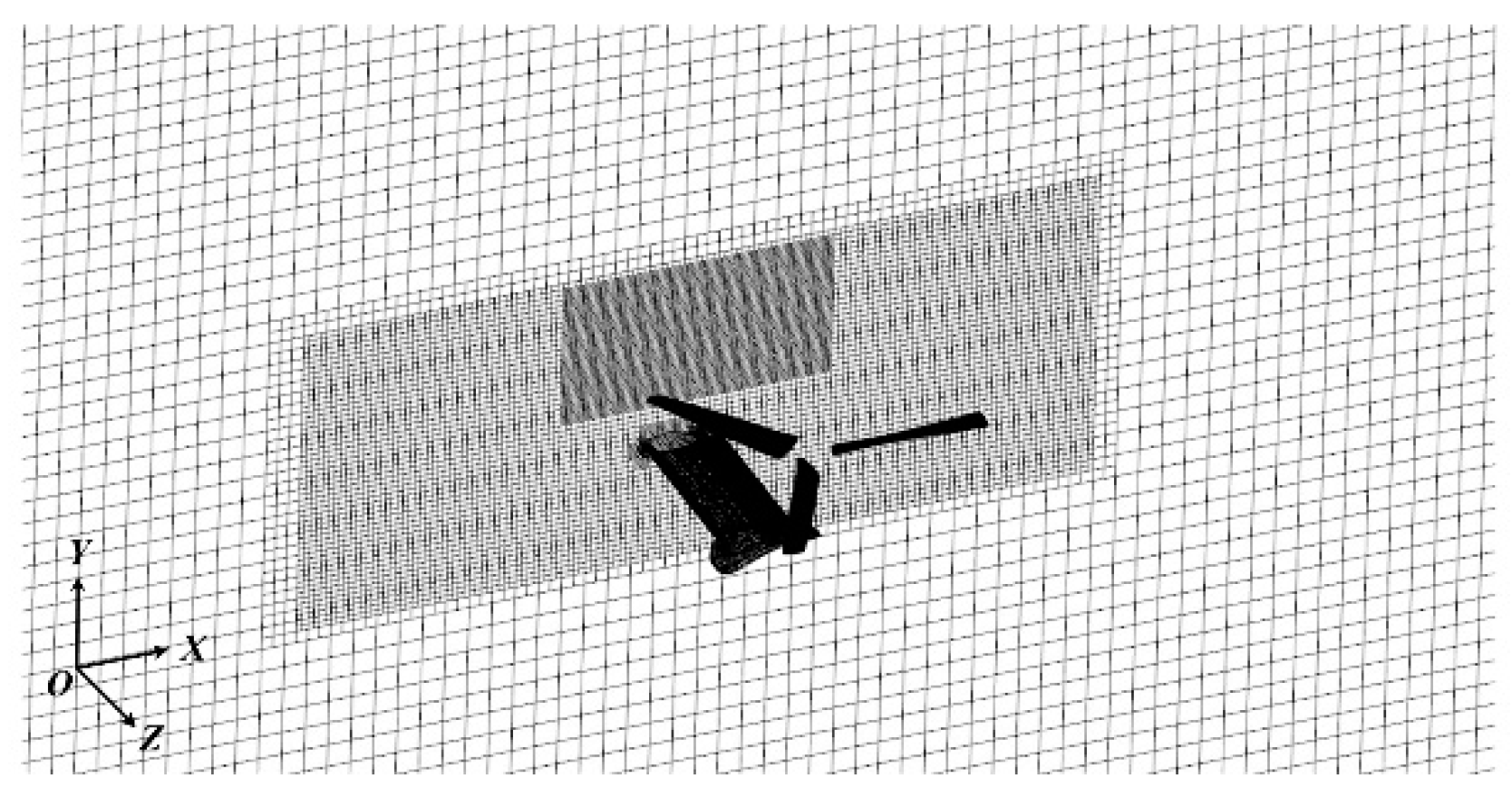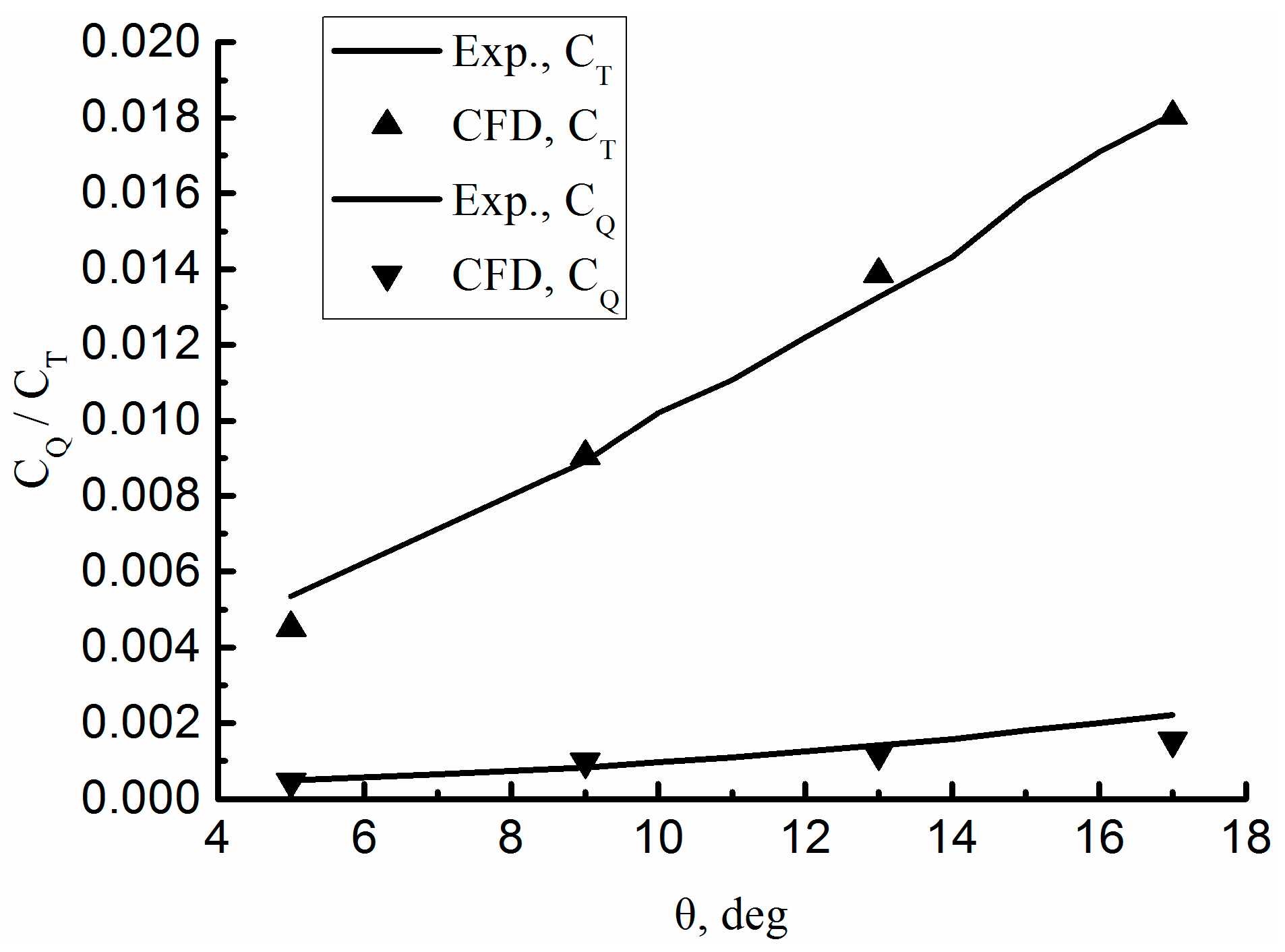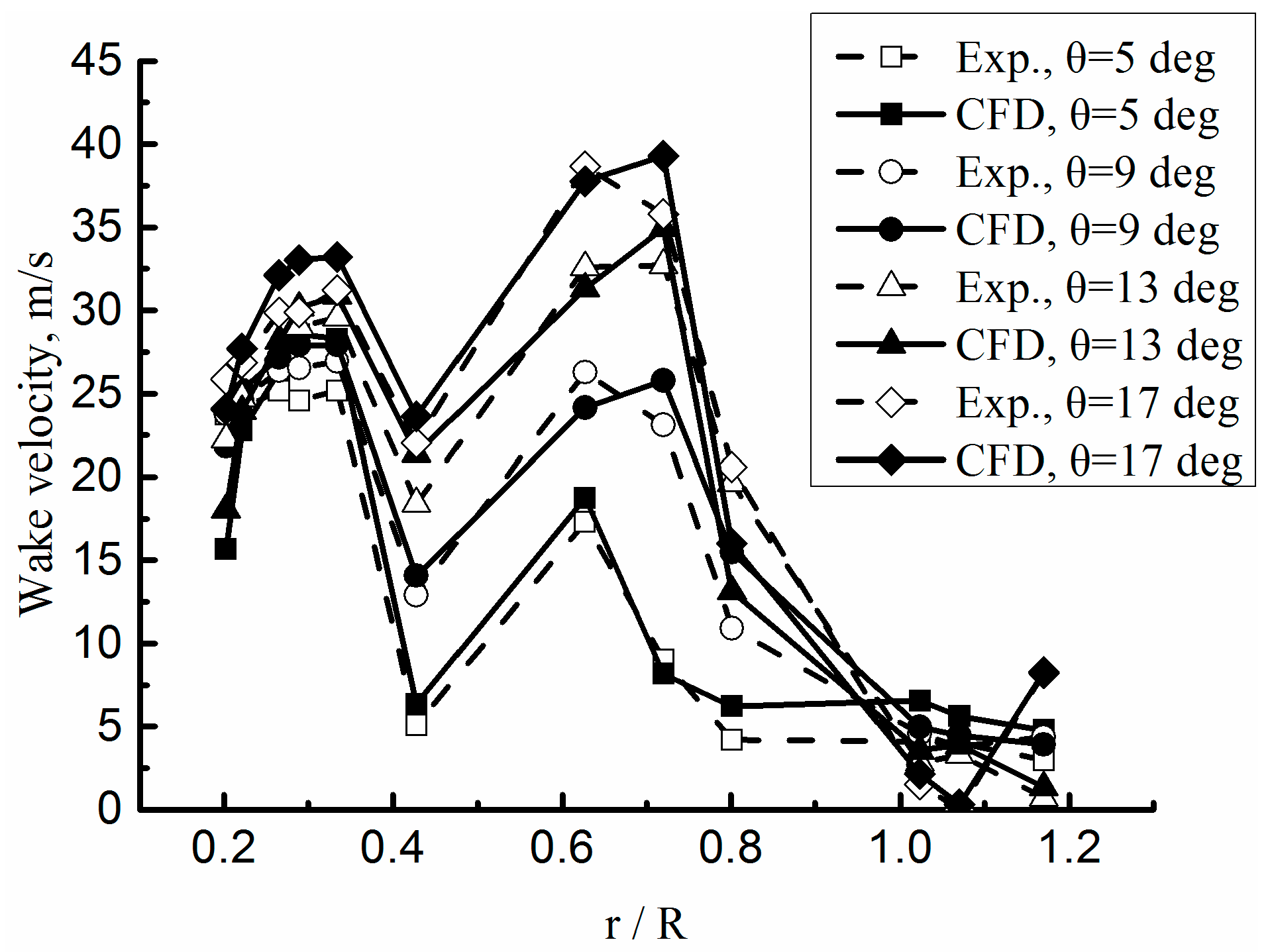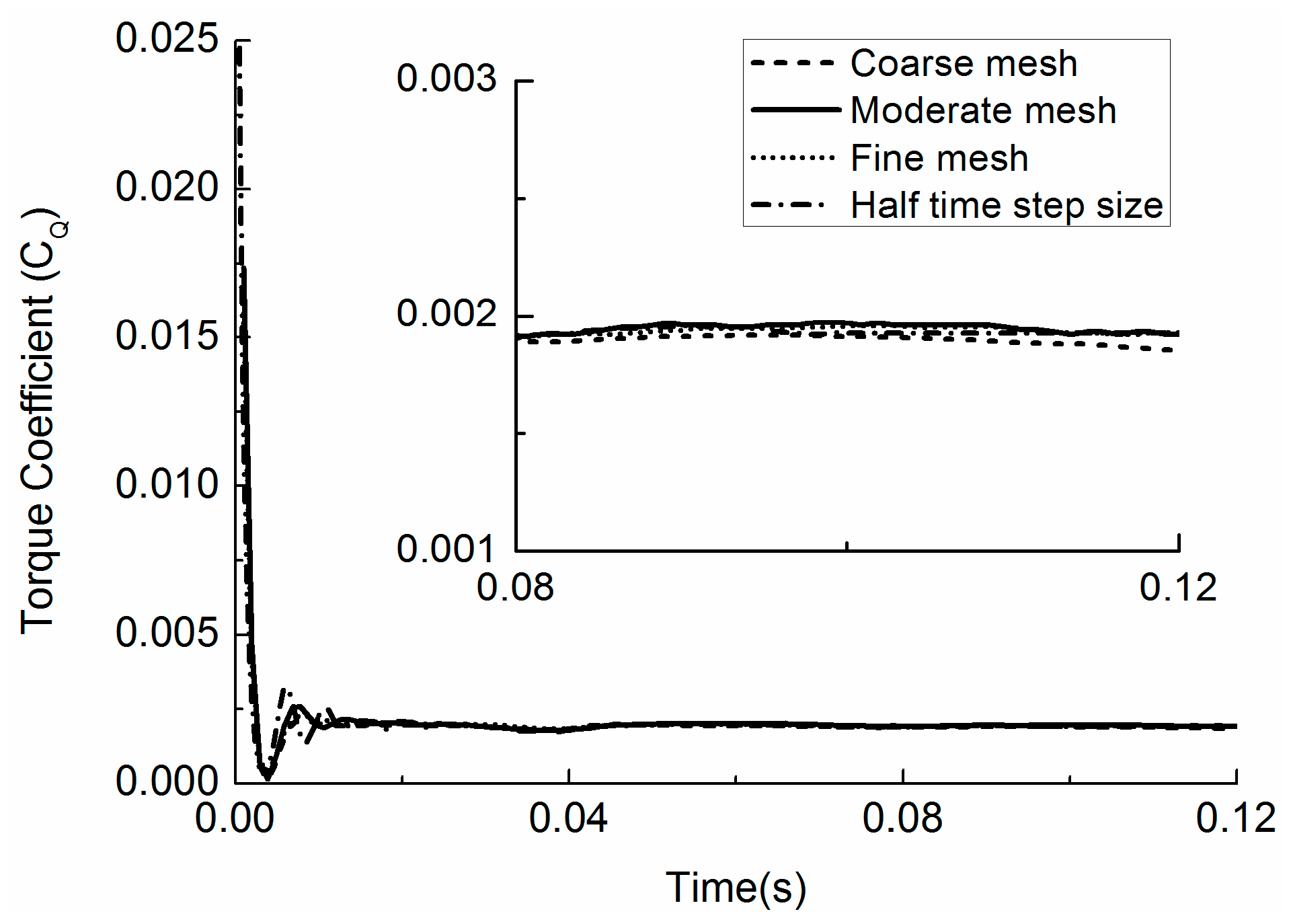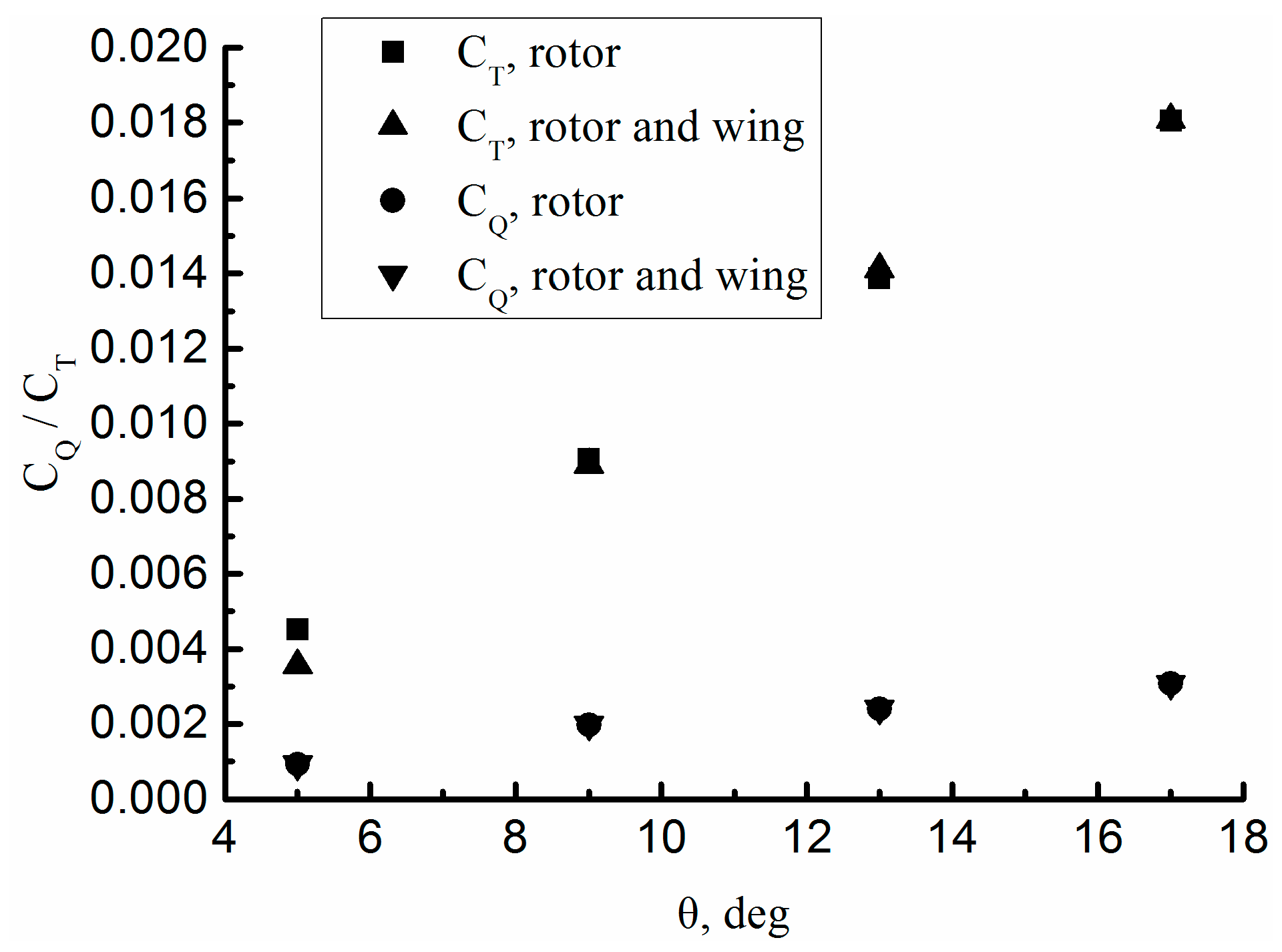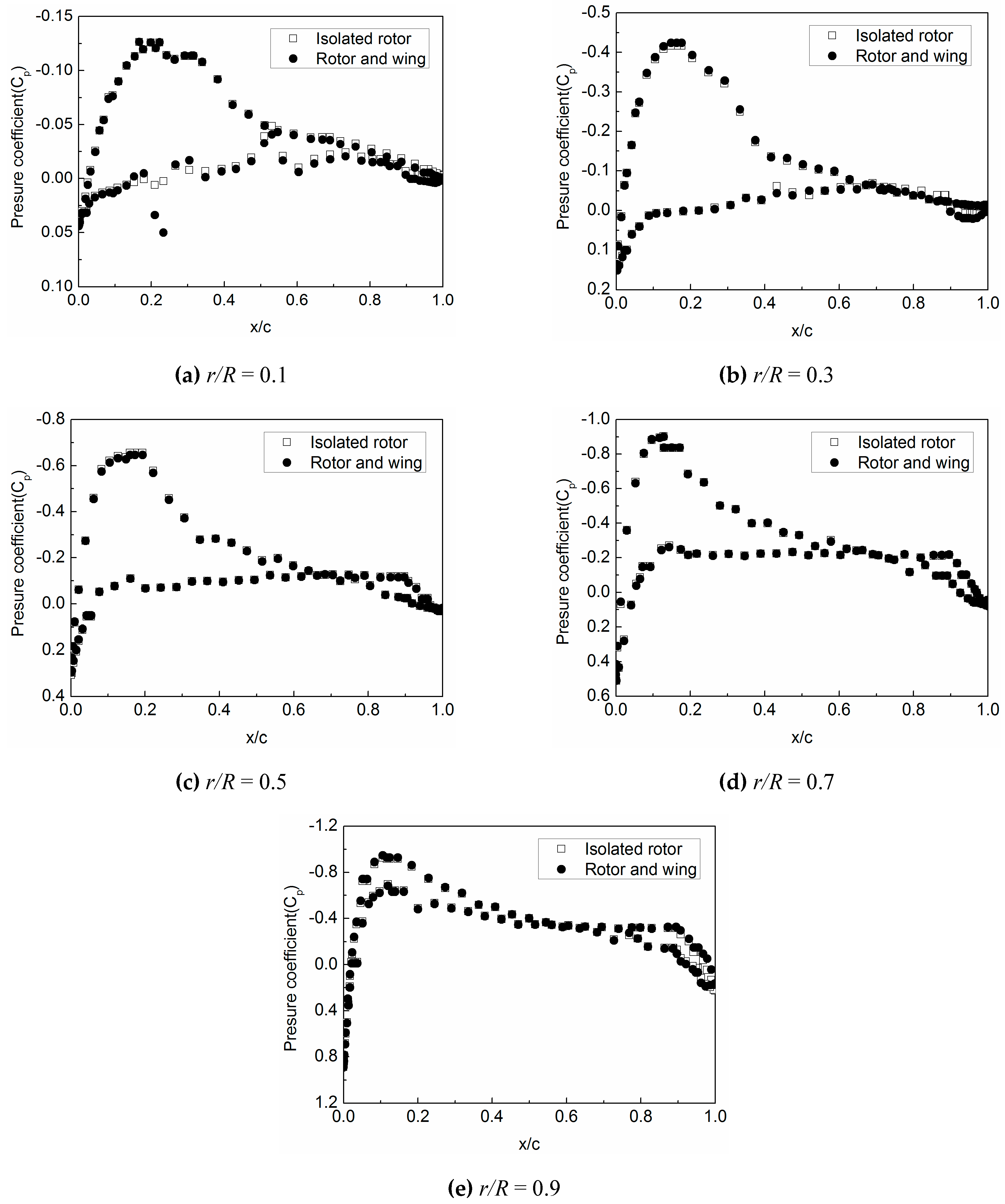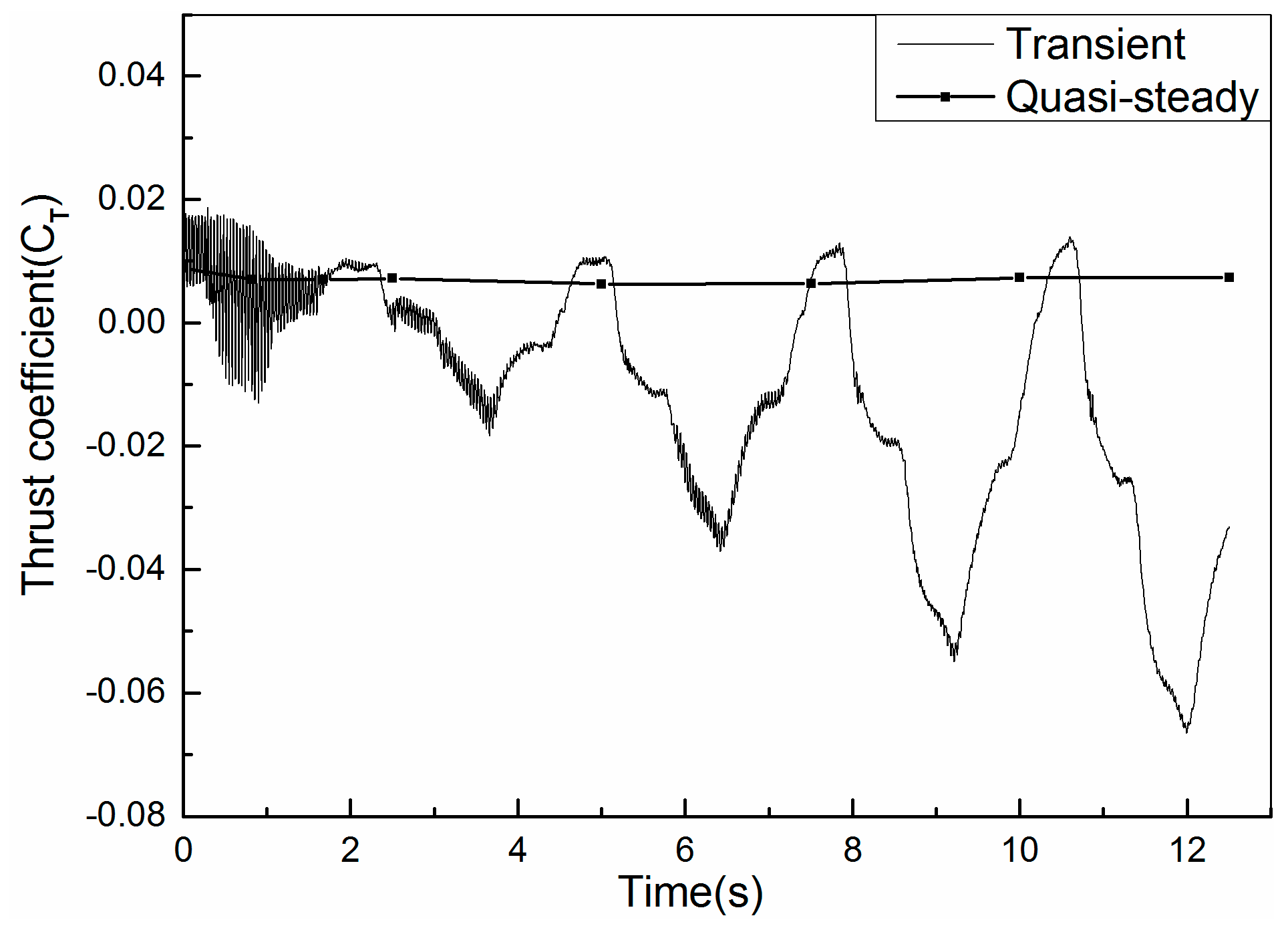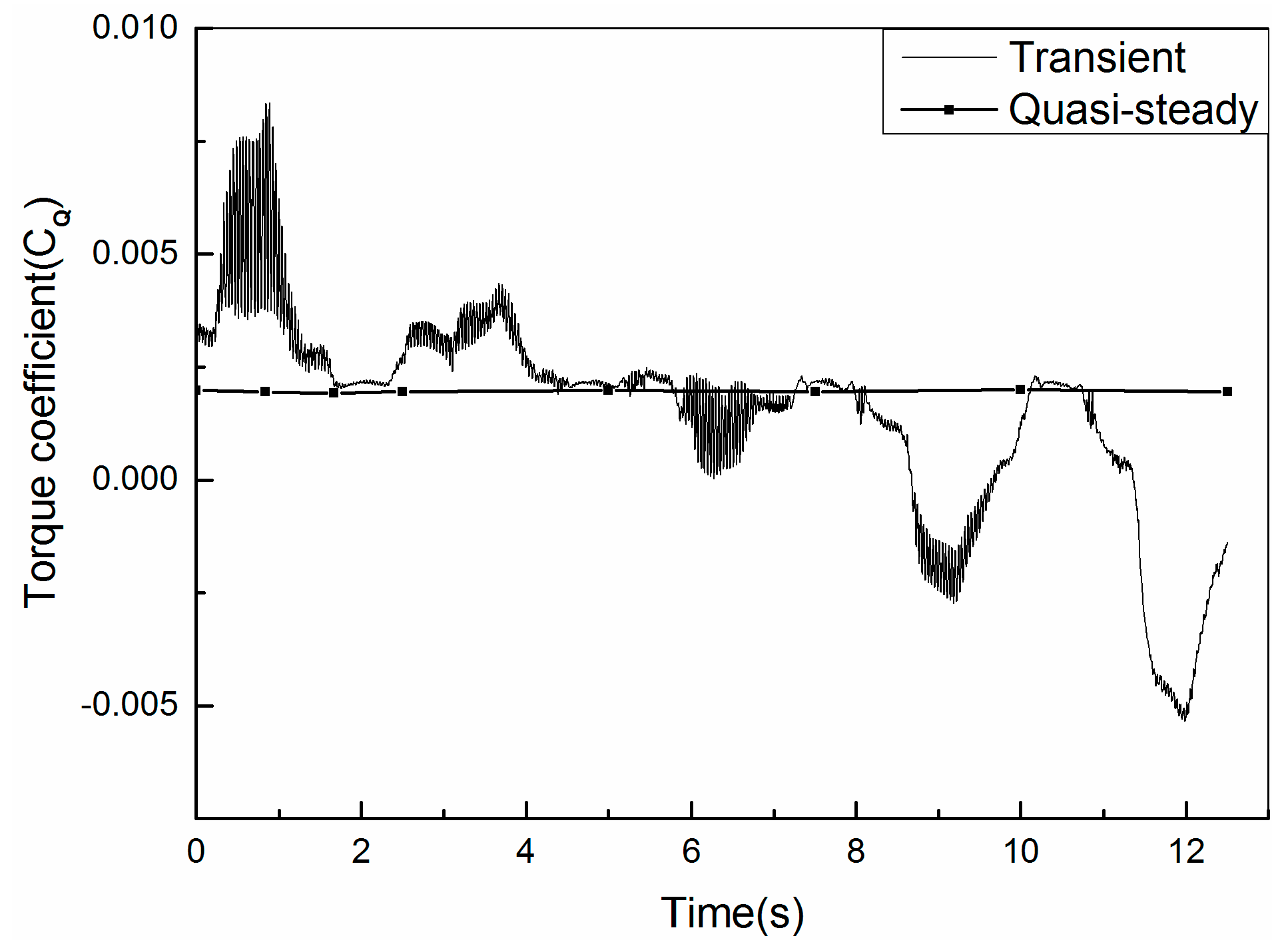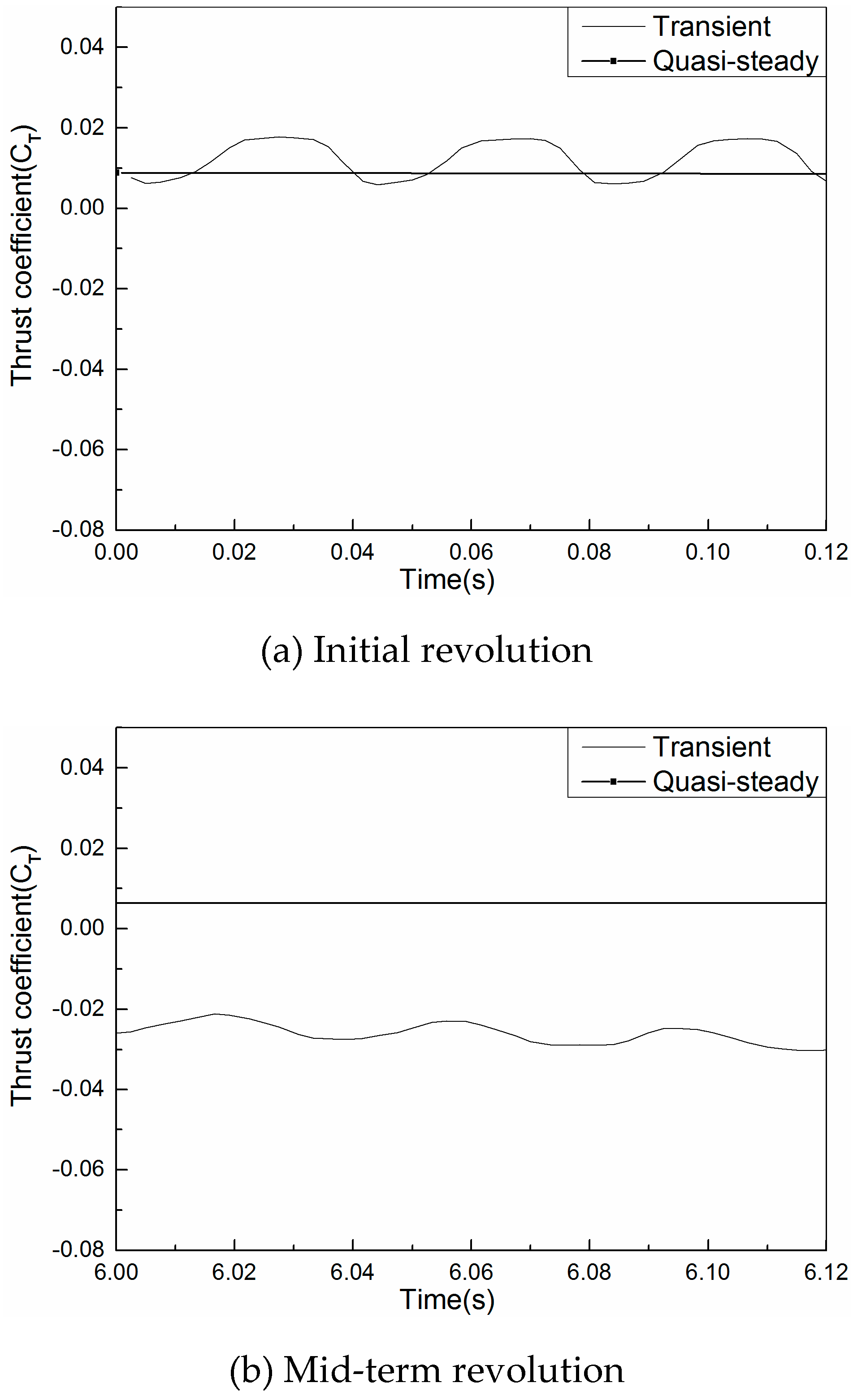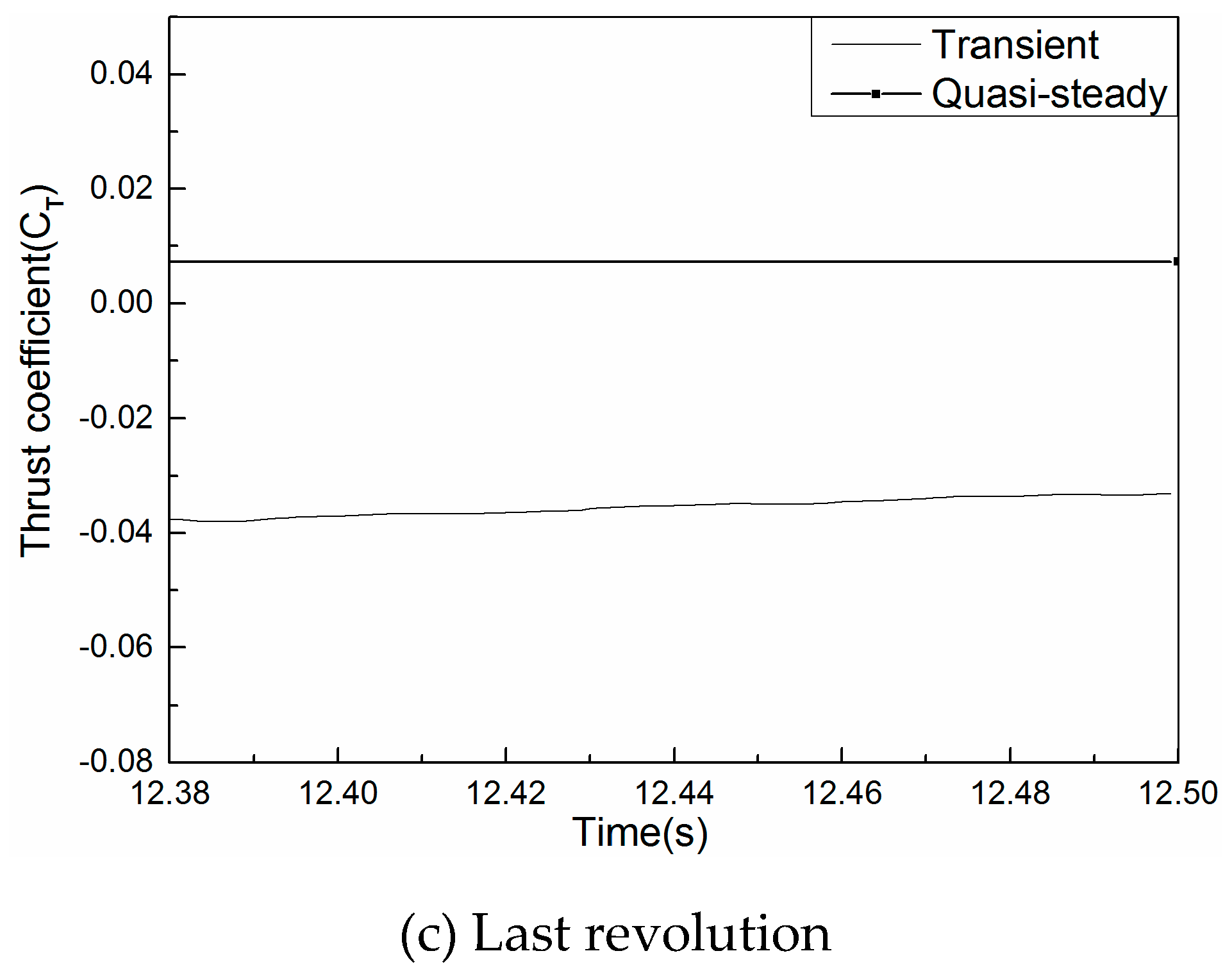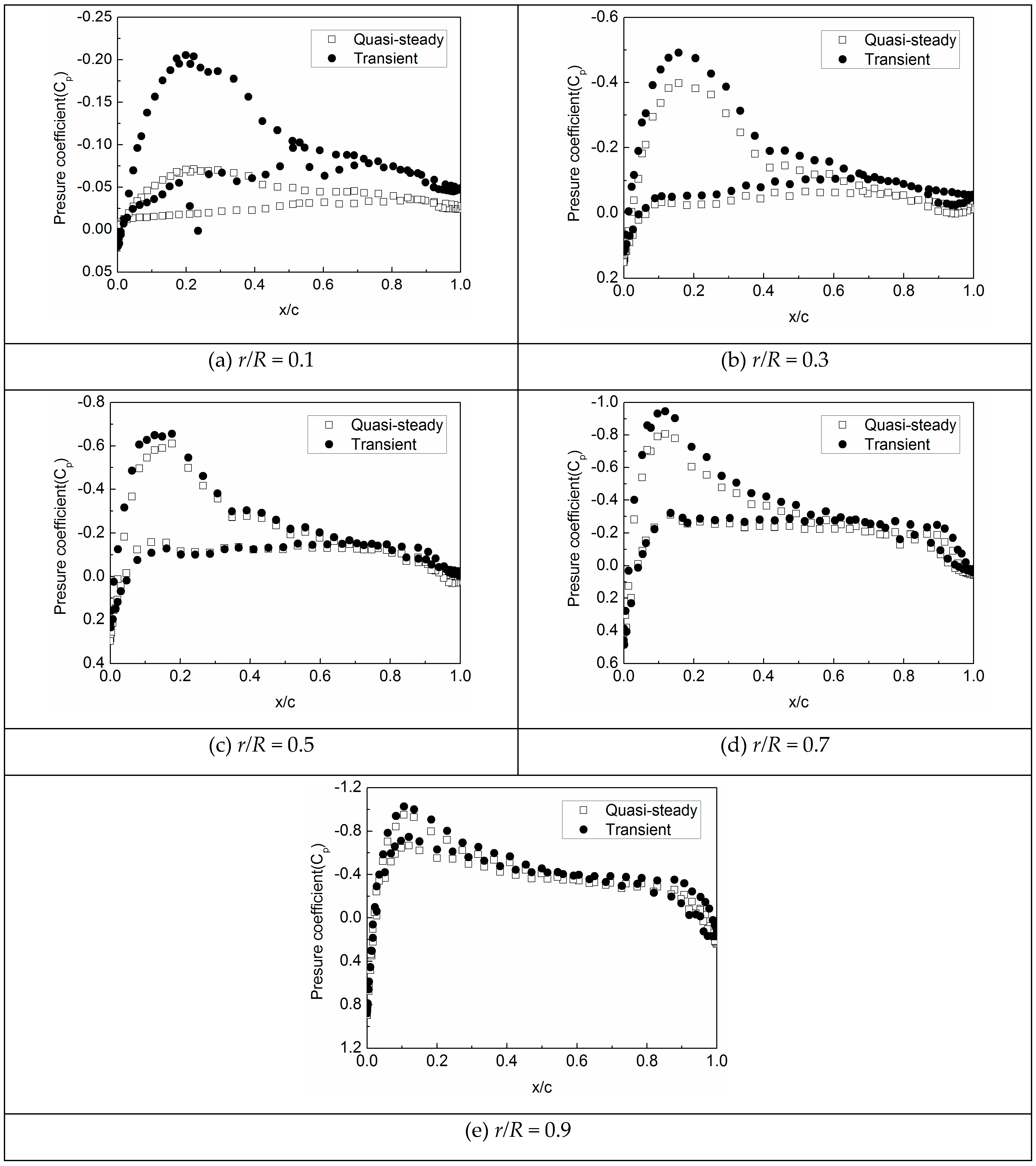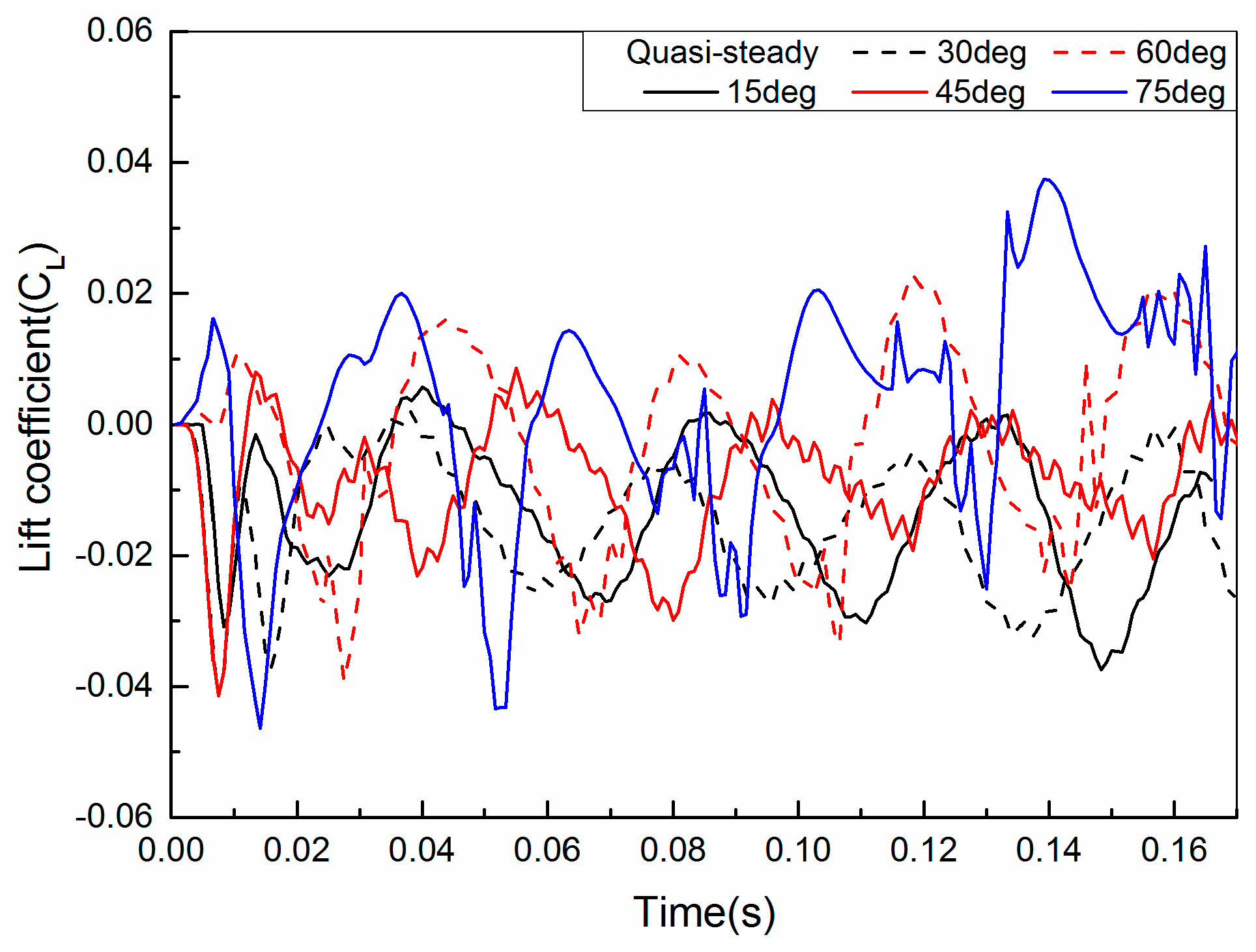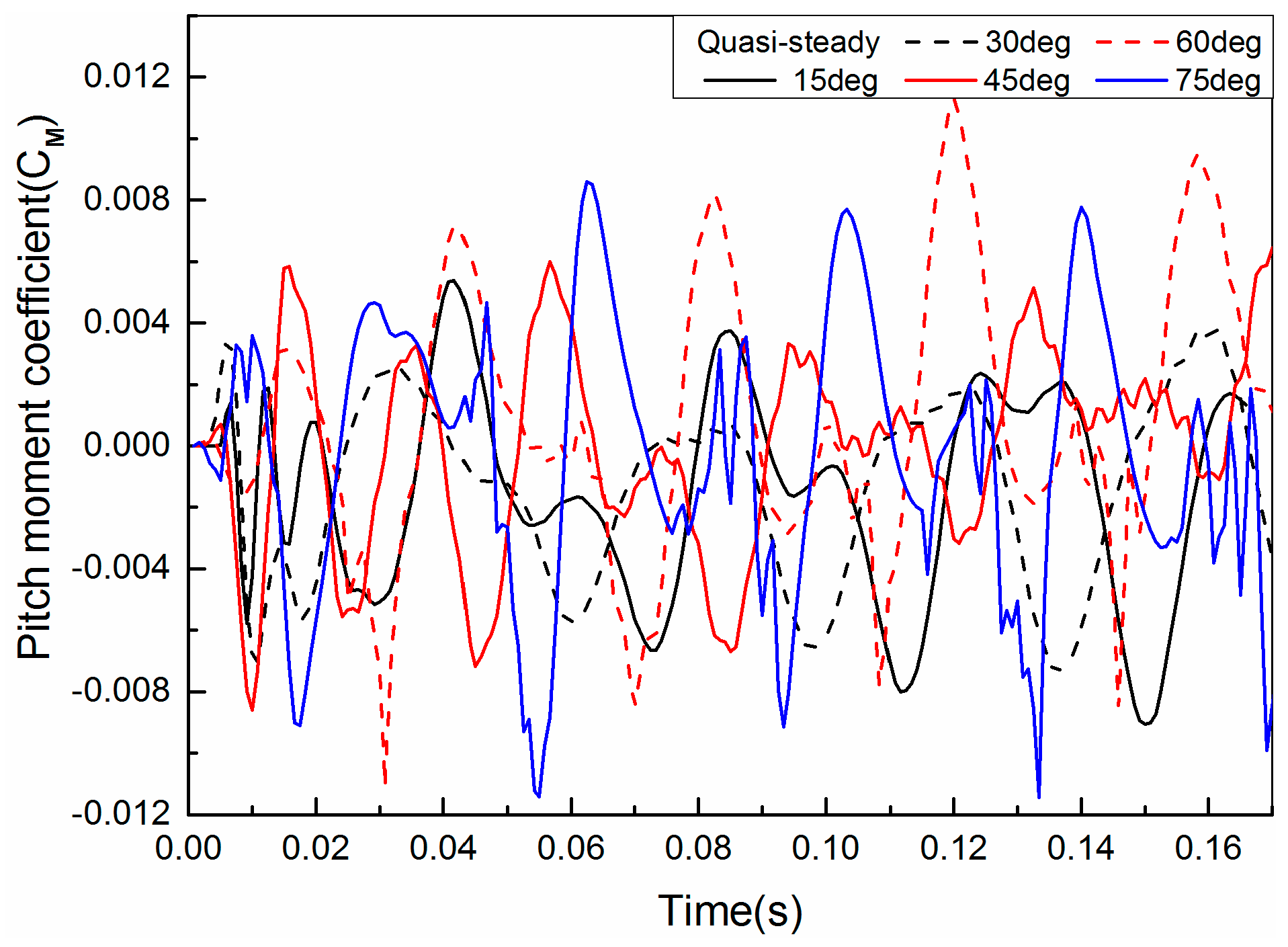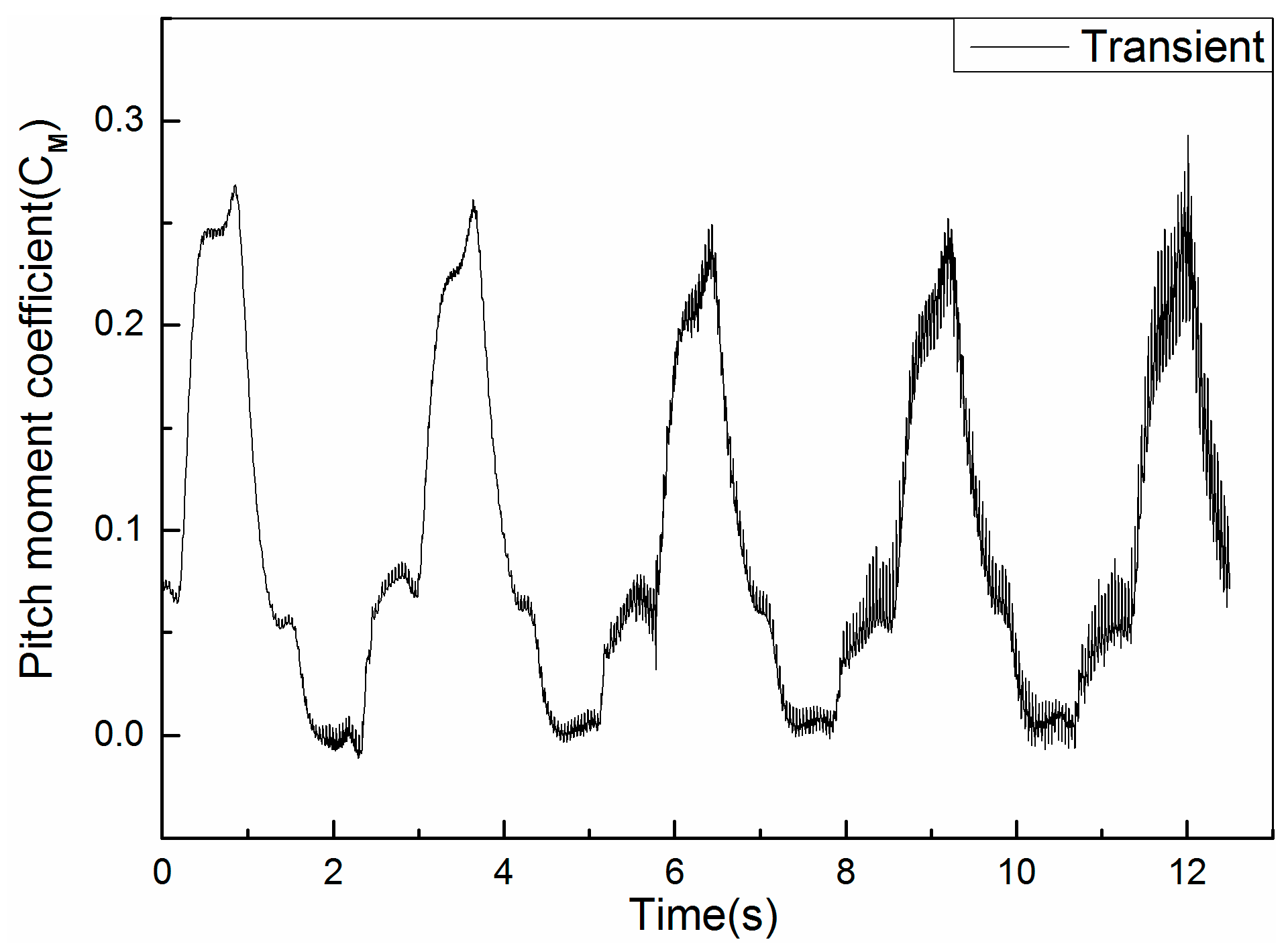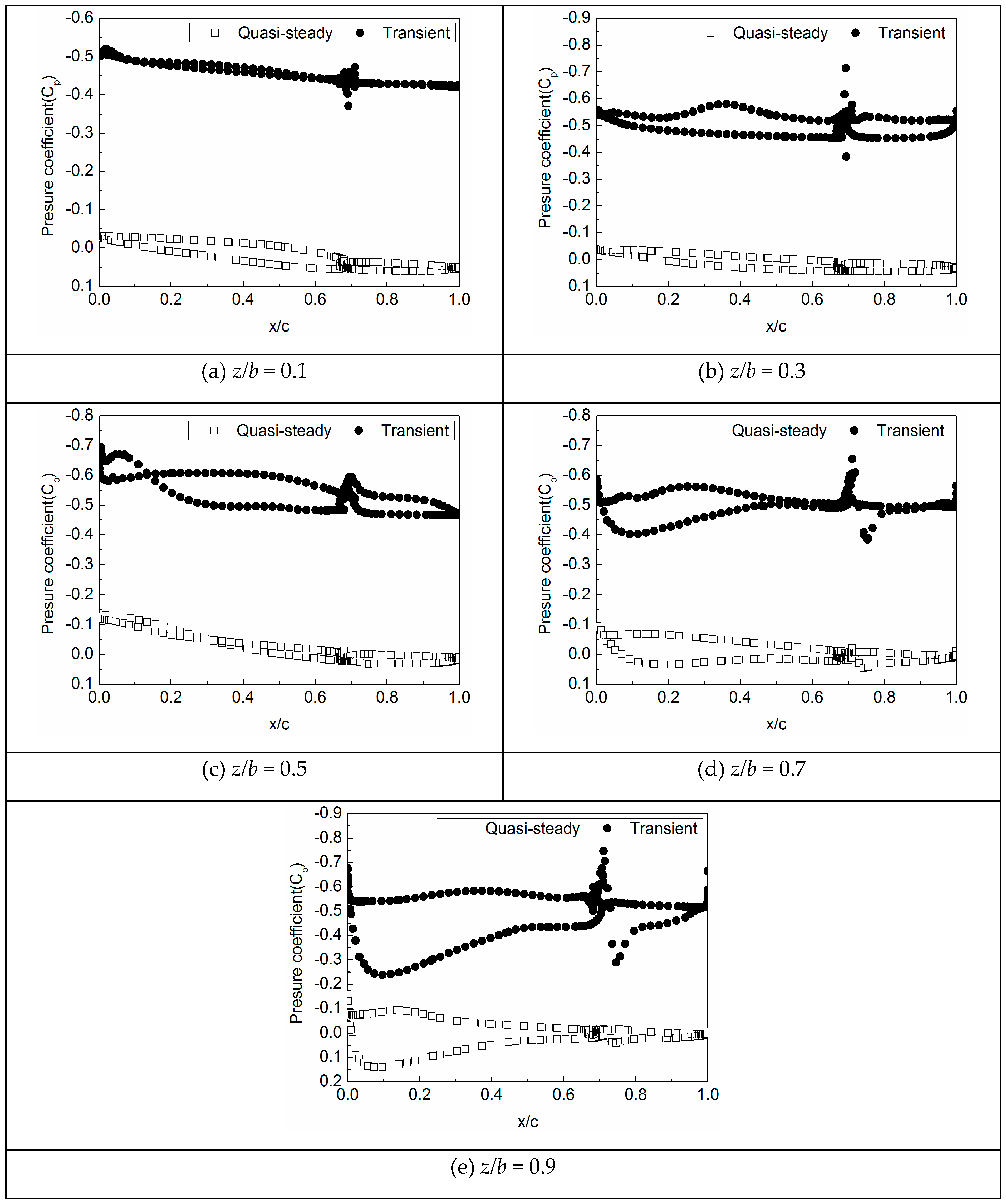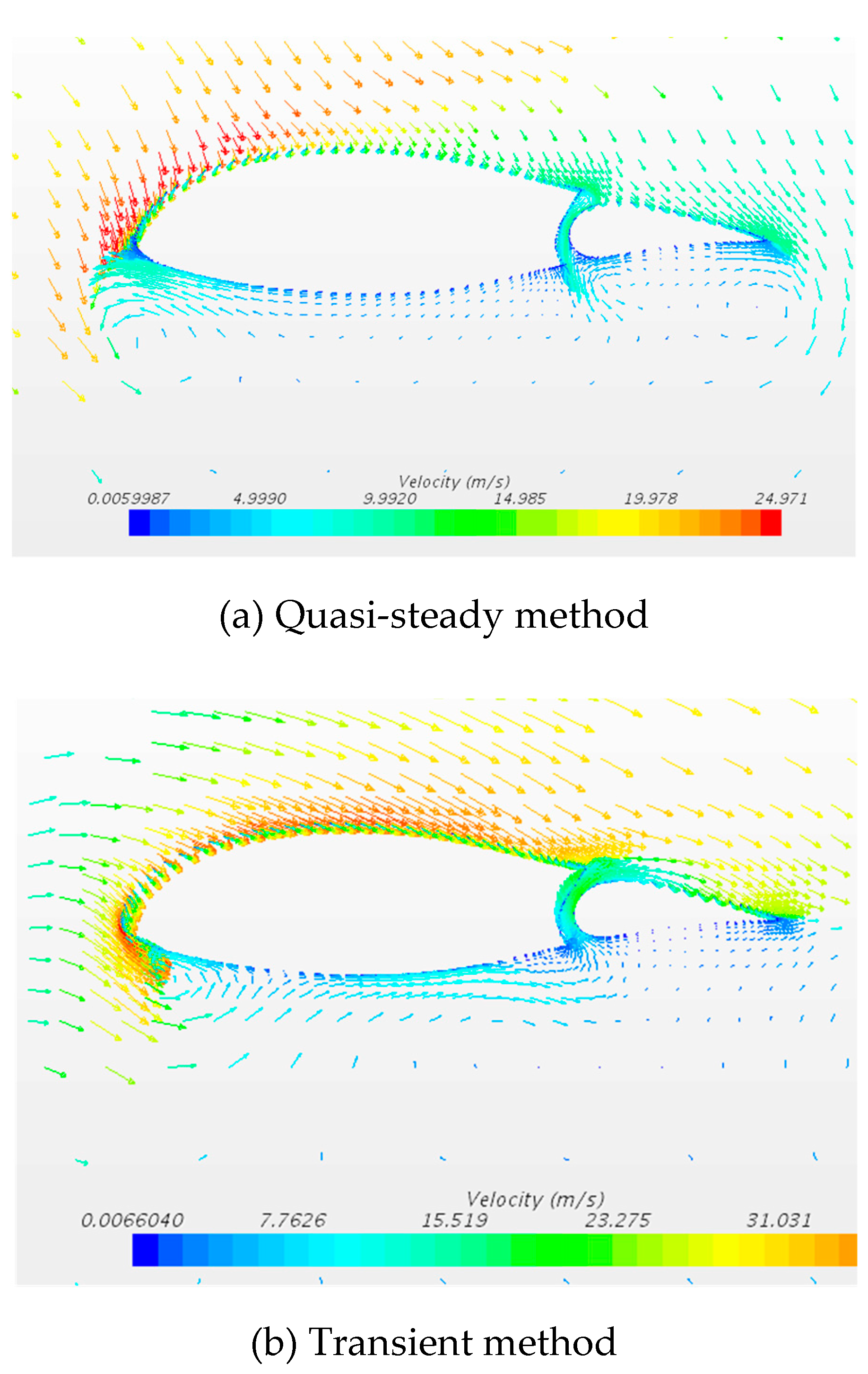1. Introduction
With several decades of research and development, tiltrotors have evolved from the 1-G and the Bell XV-3, through to the XV-15, V-22, and BA609, and have now come into service [
1]. For example, the V-22 Osprey is now serving in the military as well as many tiltrotor Unmanned Aerial Vehicles (UAVs) serve in various civil applications [
2]. Tiltrotors combine the advantages of helicopters with propeller airplane. Thus, tiltrotors can not only take off vertically and hover in the air like helicopters, but also cruise at high speeds like propeller airplanes. For their versatility, tiltrotors are showing more and more promising application perspectives in both the civil and military domains.
Tiltrotor flight conditions are classified into three modes: helicopter, transition, and airplane modes. While the helicopter and airplane modes have been extensively studied both experimentally and numerically, unfortunately, the transition mode is a relatively new research field where complex aerodynamic interactions exist. However, the transition mode is also a critical and inevitable part in the tiltrotor aerodynamic design and optimization phase. Moreover, research on tiltrotor componential aerodynamic interaction in the transition mode is also vital to provide a scientific basis for tiltrotor structural design [
3,
4].
Aerodynamically, previous studies mainly focus on tiltrotor wing performance in the helicopter mode, including both the hovering and forward flight regimes. Tests about the aerodynamic characteristics of a 0.658-scale V-22 model in hover were performed in the Ames Research Center [
5]. Data such as rotor thrust and rotor wake downwash velocities were acquired for rotor tip Mach number ranging from 0.1 to 0.73. A 0.25-scale V-22 model was tested later with rotor performance and blade structural loads, and wing pressure data were obtained [
6]. Tai numerically simulated the flow field about a wing-fuselage-nacelle configuration of the V-22 tiltrotor aircraft [
7], while Potsdam and Strawn simulated the aerodynamics of a complete V-22 tiltrotor in hover using the chimera grid methodology [
8].
A vast amount of work has been done on the helicopter and airplane modes, which cannot be exhausted here. However, due to the fact that the aerodynamic interactions between the rotor and wing of a tiltrotor in the transition mode is much more complicated compared to that in the helicopter and airplane modes, only a very small amount of literature on this topic has been released so far, and most of these studies are based on wind tunnel experiments. For example, Droandi et al. [
9] also investigated aerodynamic interaction between rotor and tilting wing in the hovering condition. Later, they also experimentally studied the proprotor–wing aerodynamic interaction in the conversion form helicopter to airplane mode [
10]. Recently, Garcia and Barakos [
11] studied the airloads on a model-scale Enhanced Rotorcraft Innovative Concept Achievement (ERICA) tiltrotor in three representative flight configurations, including a transition corridor mode by using full computational fluid dynamics (CFD) numerical simulation. However, in their work, the rotor is simplified to an actuator disk and the rotor tilt configuration is geometrically set to the specific tilt positions rather than by temporally consecutive tilting rotation from the initial position. Throughout the literature, having been open so far, there are few reports of fully transient simulations of the unsteady consecutive dynamics of tiltrotor in the transition mode.
This paper aims to explore the flowfield and aerodynamic characteristics of a scaled V-22 tiltrotor in both the hover and consecutive transition flight conditions. Our in-house code [
12], which enables fluid solutions with chimera mesh technique, is adopted for all the simulations. Results of the isolated rotor hovering performance were compared with experimental test data to show the validation of the present CFD solver. Afterwards, two methods were adopted to investigate the aerodynamics of the rotor and wing in the rotor conversion mode. One is the quasi-steady method, in which the transition phase from the helicopter mode to the airplane mode is divided into some discrete intervals and in each interval the rotor keeps rotating around the shaft in a specific tilt angle. The other one is the fully transient method where the rotor is rotating around the shaft whilst tilting around the tilt axis simultaneously. Note that, herein, the term “quasi-steady” and “transient” stand for the modeling method of the rotor tilting motion and, for all simulations in this work, the unsteady governing equations of fluid are solved. Details of the flow fields, such as thrust coefficient, pressure coefficient, and velocity contour are analyzed.
2. Methodological Description
Figure 1 shows the geometry of the 0.658-scale V-22 model but, primarily, only the wing and the rotor were used for the study in the present paper. Due to the symmetry of the model, only half of the model is simulated. The geometrical characteristics and dimensions are reported in
Table 1 (more details can be obtained from Felker [
5]).
The hole-map method [
13] for chimera mesh is adopted for the discretization of the computational domain. The general process of the mesh generation is as follows. Firstly, a background mesh for the farfield is established, which incorporates the wing as well. Local mesh density is performed near the overlapping region for the rotor as well as the regime near the wing. Afterwards, an individual rectangular grid block for one blade is generated. Local mesh density is established near the blade tip to obtain a better capture of the tip vortex effect. Subsequently, the blade block is duplicated twice and rotated correctly for the other two blades. Finally, the above four individual meshes are overset with each other to generate the interfaces of the eventual chimera grid, as shown in
Figure 2. As for the boundary conditions, both the wing and blades surfaces are set as no-slip wall. The symmetry plane of the computational domain is right the aircraft symmetric plane. All the six boundaries of the farfield are set as velocity inlet.
The unsteady compressible Reynolds-averaged Navier–Stokes (RANS) equations are adopted to solve the flow field of interest. Although direct numerical simulation (DNS) solves the time-dependent Navier–Stokes equations by resolving a wider range of spatial and temporal scales of turbulence and, thus, can show much more details of flow features than RANS, and research on DNS of low-speed wind turbine rotational flow has emerged recently [
14], simulating high Reynolds number flow, like in the present study, is not feasible even with today’s most powerful supercomputers. The rotating reference frame is attached to the rotating and tilting blades to formulate RANS equations for moving grids. The governing differential equations can be written in conservation law form in a generalized Cartesian coordinate system as follows [
15]:
where the Cartesian coordinate system
is attached to the blades with the origin overlapped with the hub center in the rotor rotating plane.
denotes time,
the vector of conserved quantities,
the source term accounting for the centrifugal acceleration of the rotating blades, and
and
are the vectors of inviscid and viscous fluxes, respectively. The subscript
stands for the corresponding variable in the three coordinate directions. They are given by
where
is Reynolds number and
is Prandtl number.
and
are, respectively, the velocity and angular velocity components in the corresponding directions of
,
heat flux components,
density,
total energy,
static pressure, and
shear stress, described below.
The Menter SST (Shear Stress Transport) k-ω turbulence model [
16] has been widely validated to be suitable for flows with adverse pressure gradients and large rotations, especially for various rotor flows [
17,
18,
19,
20,
21]. Particularly, Kau et al. [
20] conducted a comparison between HMB (Helicopter Multi-Block) and CFD data using the OVERFLOW2 solver, where the SST k-ω turbulence model was employed. A fair agreement was found for the surface pressure coefficient at all radial stations. Yoon et al. [
21] compared the figure or merit (FM) obtained by the SST k-ω model with those from the SA (Spalart-Allmaras) model and experiments, and found that the FM using the SST model has only a 0.9% relative error with respect to the experimental result, and is slightly closer to experimental results than the SA FM. A recent work from the current research group also showed that the SST k-ω model is suitable for rotor rotational flows [
22]. Therefore, with reference to the practice of many other studies and our own experience on rotor flows, the SST k-ω model is also utilized to model the turbulence effect in the present study. It is a combination of the original k-ω model and the k-ε model, which is obtained by the original k-ω model multiplied by a function
plus the transformed k-ε model multiplied by a function
. The kinematic eddy viscosity equation of Menter SST k-ω turbulence model [
14] is written as
where
.
is the eddy viscosity defined as
, where
is the absolute value of the vorticity and
is a function defined below. Let
,
,
represent any constant in the original k-ω model, k-ε model, and the above SST k-ω model, respectively. Then, the relation between them is
The constants of set 1 (
) are
The constants of set 2 (
) are
Numerical activities were carried out, including the isolated rotor in hover, wing, and rotor in hover and transition. The rotor rotating and tilting rates are 53.94 and 0.1047 rad/s, respectively. In order to assure the simulation fidelity of the transition process, as well as the numerical convergence, the time step size of 9.7 × 10−4 s is chosen for no-tilt cases so that the rotor rotates 3 degrees per time step, while for cases with rotor tilt motions it is set as 8.33 × 10−4 so that the rotor tilts about 0.005 degrees per time step. The numerical results of the rotor in hover are compared with the experimental data to show the validity of the present solver. The simulations of the wing and rotor in transition were analyzed by two methods: a quasi-steady method and a fully transient method. The grid dependence was studied when the rotor shaft was at 0 degree in transition using the quasi-steady method.
4. Conclusions
In this paper, a numerical investigation of the aerodynamic interactions between the rotor and wing of the V-22 Osprey tiltrotor in both the helicopter and transition modes is presented. The computational domains are discretized by chimera mesh technique and solved with the RANS equations with an additional source term to account for the centrifugal acceleration of the rotating blades.
The numerical accuracy is firstly validated by comparing the results for the isolated rotor case by the current simulation with the results from the wind tunnel experiment in the literature. Then, the case of wing and rotor in hovering helicopter mode was studied. It was found that the presence of the wing does not impart significant influence on the pressure distribution, as well as the aerodynamic forces on the rotor. Finally, the case of the wing and rotor in the transition mode at a constant forward flight velocity is simulated. Both a quasi-steady and a fully transient method are employed to simulate the tilt motion of the rotor in the transition process. It is indicated that remarkable difference appears between the results by the two methods. The transient method considers the unsteadiness of the flow field and the centrifugal force due to the real tilt motion of the rotor, thus provides better prediction accuracy.
On the one hand, the results presented in this paper provide some more insights into the flow physics and mechanisms in tiltrotor transition aerodynamics: (1) As the tilt angle increases, the wing is more largely exposed in the downwash of the rotor, and the aerodynamic interactions between the rotor and wing become more intense, causing increasing oscillation amplitudes in the rotor thrust and torque. Meanwhile, the blockage effect of the wing on the rotor downwash flow becomes stronger with the increasing tilt angle, resulting in gradual decrease in the mean values of the rotor thrust and torque. (2) The unsteadiness of the flow field and the centrifugal force due to the real rotation of the rotor are indispensible considerations for more accurate predictions of rotor and wing aerodynamic forces and moments in the transition mode. (3) As the tilt angle increases, the oscillation of the wing lift and pitching moment become more intense, which is also due to the larger exposed area of the wing in the rotor downwash.
On the other hand, through this paper, the limitations of the extensively used quasi-steady method for simulation of tiltrotor transition process are revealed: (1) As for the rotor aerodynamics, the quasi-steady method is only accurate at the blade tip positions. Due to its lack in consideration of the unsteadiness and centrifugal force in a real tilt motion of rotor, the accuracy of the quasi-steady method becomes worse at more inboard positions to the blade root. (2) As for the wing aerodynamics, the quasi-steady method is not able to simulate the temporally continuous flowfield characteristics near the wing, thus, it is recommend not use this method to predict the aerodynamics of the wing for a tiltrotor aircraft. These results are new and may be helpful for practical tiltrotor aerodynamic design and optimization.
